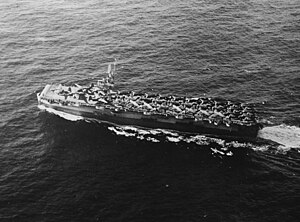USS Fanshaw Bay (CVE-70)
 |
|
| History | |
|---|---|
| Name: | USS Fanshaw Bay |
| Ordered: | 18 June 1942 |
| Builder: | Kaiser Shipyards |
| Laid down: | 18 May 1943 |
| Launched: | 1 November 1943 |
| Commissioned: | 9 December 1943 |
| Decommissioned: | 14 August 1946 |
| Struck: | 1 March 1959 |
| Fate: | Sold for scrap 26 September 1959 |
| General characteristics | |
| Class and type: | Casablanca-class escort carrier |
| Displacement: | 7,800 tons |
| Length: | 512 ft 3 in (156.13 m) overall |
| Beam: |
|
| Draft: | 22 ft 6 in (6.86 m) |
| Propulsion: |
|
| Speed: | 18 knots (33 km/h) |
| Range: | 10,240 nmi (18,960 km) at 15 kn (28 km/h) |
| Complement: | 764 |
| Armament: |
|
| Aircraft carried: |
|
| Service record | |
| Part of: | United States Pacific Fleet |
| Operations: | |
| Awards: | |
USS Fanshaw Bay (CVE-70) was a Casablanca-class United States Navy escort aircraft carrier, launched 1 November 1943 by Kaiser Shipbuilding Company, Vancouver, Washington, sponsored by Mrs. J. L. Kenworthy, Jr.; and commissioned 9 December 1943, Captain Douglass P. Johnson in command. She was reclassified CVHE-70 on 12 June 1955.
Fanshaw Bay sailed from San Diego 6 April 1944 with Rear Admiral Gerald F. Bogan, Commander Carrier Division 25, embarked, and reached Majuro 20 April. After 10 days of antisubmarine patrols and air searches out of Majuro, she returned to Pearl Harbor for replenishment and training. She sailed 29 May for Eniwetok and final preparations for the assault on Saipan, for which she sailed 11 June.
Operating about 30 miles east of Saipan, Fanshaw Bay launched antisubmarine patrols, combat air patrol, and photographic reconnaissance flights as well as raids on Japanese positions to pave the way for the invasion on 15 June. During an attack by five enemy aircraft on that day, Fanshaw Bay saved herself from a torpedo by prompt maneuvering, but two days later in a melee of raids from all sides which included about 70 Japanese planes, Fanshaw Bay was struck by a bomb, after her antiaircraft guns and fighter planes had splashed many of the attackers. The bomb penetrated the after elevator and exploded in midair above the hangar deck, killing 14 and wounding 23. Fires broke out, and the fire main was ruptured, flooding several compartments aft. In just under an hour the damage was brought under control, but Fanshaw Bay listed 3° to port and settled 6 feet by the stern. She transferred Rear Admiral Bogan to a destroyer, and sailed for Pearl Harbor for battle damage repairs.
Fanshaw Bay arrived at Manus on 28 August 1944 for training in preparation for the invasion of Morotai, for which she sailed 10 September, with Rear Admiral Clifton Sprague, the new division commander, embarked. Her planes flew combat air patrol and support missions, and on 16 September provided air cover for one of the pilots, down just a few hundred feet off the enemy-held shore of Wasile Bay. Diving low, they provided protection until two daring motor torpedo boats dashed in to snatch him out from under enemy shore guns. The escort carrier replenished at Manus from 7 October to 12 October, then put out for the invasion of Leyte on 20 October.
...
Wikipedia
